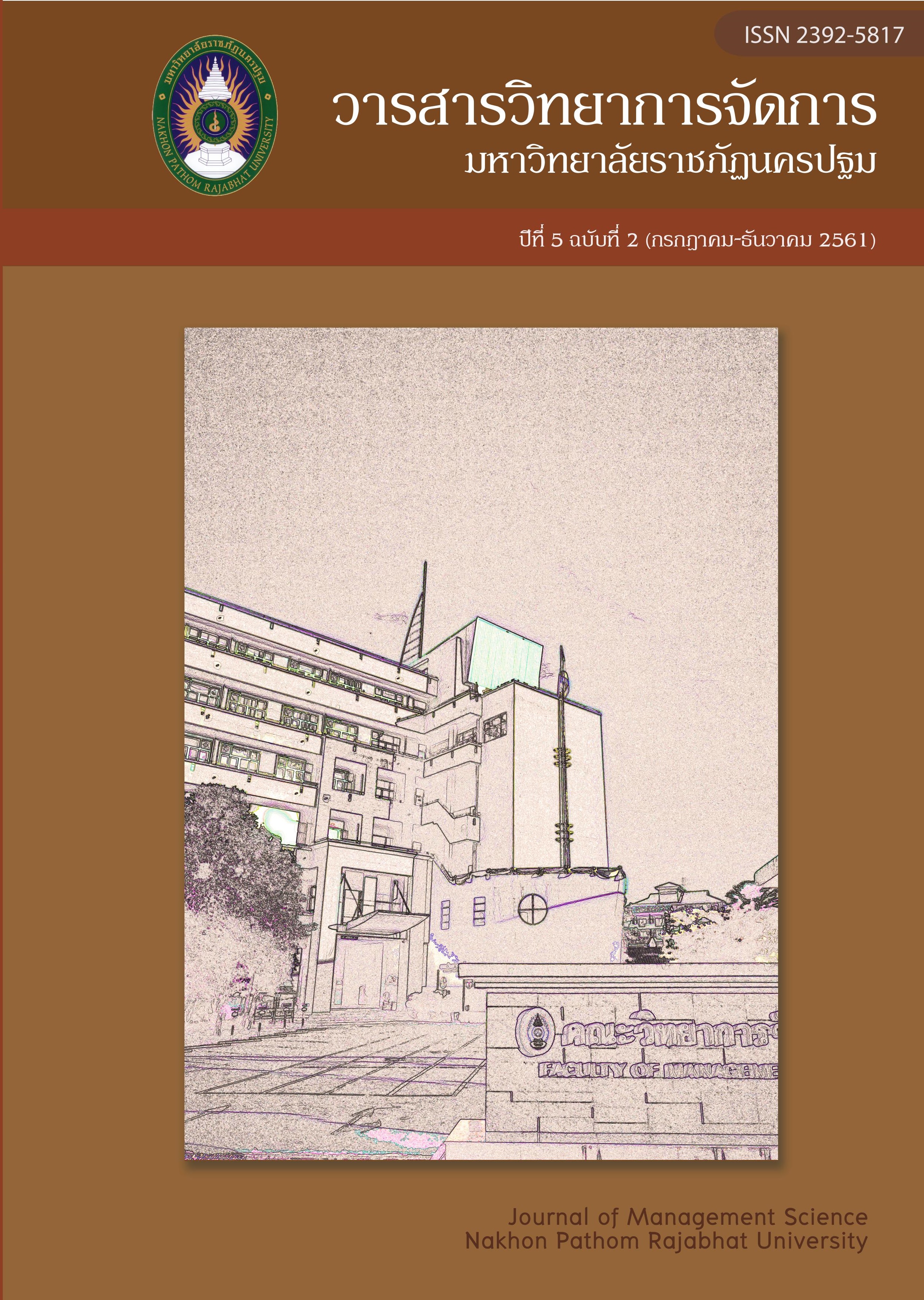Guidelines for health behavior promotion of the supporting staffs in the faculty of medicine, Ramathibodi Hospital
Main Article Content
Abstract
The objectives of this research were to: 1) study the quality of working life, perception factors in health behavior, and health-promoting behavior of supporting staff; 2) compare the health-promoting behavior of supporting staff, as classified by personal factors; 3) analyze the relationship between quality of working life and health-promoting behavior of supporting staff; and 4) identify the guidelines for health behavior promotion of supporting staff. The research sample consisted of 348 supporting staff in Faculty of Medicine, Ramathibodi Hospital, derived by proportional stratified random sampling as distributed by department; and 3 interviewees derived by purposive sampling. The research instruments were a questionnaire and an in-depth interview form constructed by the researcher. The questionnaire had IOC content between 0.67-1.00. The internal consistency reliability coefficients were 0.89 for quality of working life, 0.93 for perception of health behavior, and 0.94 for health behavior promotion. Data were analyzed with percentage, mean, standard deviation, t-test, one-way analysis of variance, least significant difference analysis, correlation coefficient, and content analysis.
The findings of this research were as follows:
1. Overall the quality of working life of supporting staff was at a high level. When considering each aspect, the aspect with the highest average was social relationship in organization. The overall perception of health behavior was at a high level. When considering each aspect, the aspect with the highest average was perception in benefits of health behavior practice. The health promotion behavior was overall at a high level. Specifically, the aspect with the highest average was holistic health development.
2. Supporting staff as classified by age and marital status had different levels of health-promoting behavior with statistical significance at .05. However, there was no difference among those classified by monthly income, educational level, and type of position.
3. The quality of working life was associated with health promotion behavior. The top three aspects were attitude toward health behavior practice (rxy= 0.368), situational influence (rxy= 0.345), and self-efficacy perception (rxy= 0.327).
4. Guidelines for health behavior promotion of supporting staff were as follows: 1) receiving support in budget and health promotion; 2) planning and organizing a training project in health issues; 3) giving health advices after the training; 4) following up and summarizing the training result, and presenting to the executives; and 5) following 3 health principles: food, emotion, and exercise, and creating model in healthy living and health caring.
Article history : Received 18 July 2017
Revised 8 October 2017
Accepted 18 October 2017
SIMILARITY INDEX = 1.21
Article Details
The views and opinions of the article appearing in this journal are those of the author. It is not considered a view and responsibility of the editorial staff.
References
คณะแพทยศาสตร์โรงพยาบาลรามาธิบดี, สำนักงานคณบดี, งานนโยบายและแผน. (2558). รายงานประจำปี 2558. กรุงเทพฯ : ธนาเพรส.
จารุทัศน์ ตั้งกีรติชัย. (2552). ปัจจัยที่มีผลต่อพฤติกรรมการส่งเสริมสุขภาพในด้านการบริโภคอาหารของบุคลากร กรมสนับสนุนบริการสุขภาพ กระทรวงสาธารณสุข.วิทยานิพนธ์วิทยาศาสตรมหาบัณฑิต.สาขาวิชาสุขศึกษา.บัณฑิตวิทยาลัย มหาวิทยาลัยเกษตรศาสตร์.
นพวรรณ ใจคง. (2555).คุณภาพชีวิตในการทำงานของพนักงานโรงพยาบาลพญาไท ศรีราชา จังหวัดชลบุรี.วิทยานิพนธ์รัฐประศาสนศาสตรมหาบัณฑิต.สาขาวิชาการบริหารทั่วไป วิทยาลัยการบริหารรัฐกิจ.มหาวิทยาลัยบูรพา.
บุญเรือง ชัยสิทธิ์.(2551). พฤติกรรมส่งเสริมสุขภาพของเจ้าหน้าที่สาธารณสุขจังหวัดอุบลราชธานี. วิทยานิพนธ์สาธารณสุขศาสตรมหาบัณฑิต.สาขาวิชาการสร้างเสริมสุขภาพบัณฑิตวิทยาลัย.มหาวิทยาลัยราชภัฏอุบลราชธานี.
ประไพพันธ์ บัวพรมมี. (2553). พฤติกรรมส่งเสริมสุขภาพของบุคลากร มหาวิทยาลัยสุโขทัยธรรมาธิราช จังหวัดนนทบุรี. วิทยานิพนธ์ศึกษาศาสตรมหาบัณฑิต. สาขาวิชาสุขศึกษา. บัณฑิตวิทยาลัย. มหาวิทยาลัยรามคำแหง.
ปุรินทร์ ศรีศศลักษณ์. (2557). ปัจจัยที่มีอิทธิพลต่อพฤติกรรมส่งเสริมสุขภาพของอาจารย์พยาบาลวิทยาลัยพยาบาลเครือข่ายภาคกลาง กระทรวงสาธารณสุข.วิทยานิพนธ์พยาบาลศาสตรมหาบัณฑิต. สาขาวิชาการพยาบาลเวชปฏิบัติชุมชน บัณฑิตวิทยาลัยมหาวิทยาลัยคริสเตียน.
สุพัตรา การะเกตุ. (2556). ปัจจัยที่มีความสัมพันธ์กับพฤติกรรมการส่งเสริมสุขภาพของบุคลากรในโรงพยาบาลกลาง กรุงเทพมหานคร. วิทยานิพนธ์วิทยาศาสตรมหาบัณฑิต. สาขาวิชาสุขศึกษาบัณฑิตวิทยาลัย. มหาวิทยาลัยเกษตรศาสตร์.
สุภาวดี พรหมมา. (2553). ปัจจัยที่มีผลต่อพฤติกรรมการส่งเสริมสุขภาพในด้านการบริโภคอาหารของบุคลากร กรมอนามัย กระทรวงสาธารณสุข. วิทยานิพนธ์วิทยาศาสตรมหาบัณฑิต. สาขาวิชาสุขศึกษาบัณฑิตวิทยาลัย. มหาวิทยาลัยเกษตรศาสตร์.
สุวิภา อนุจรพันธ์. (2550). ปัจจัยที่มีความสัมพันธ์กับพฤติกรรมการส่งเสริมสุขภาพของข้าราชการทหารระดับชั้นสัญญาบัตรในศูนย์รักษาความปลอดภัย กองบัญชาการทหารสูงสุด.วิทยานิพนธ์วิทยาศาสตรมหาบัณฑิต สาขาวิชาสุขศึกษาบัณฑิตวิทยาลัย. มหาวิทยาลัยเกษตรศาสตร์.
เอกวิทย์ ปฏิสัมภิทากุล. (2554). ปัจจัยที่มีความสัมพันธ์กับพฤติกรรมการส่งเสริมสุขภาพของบุคลากรในสถาบันราชานุกูล. วิทยานิพนธ์วิทยาศาสตรมหาบัณฑิต สาขาวิชาสุขศึกษาบัณฑิตวิทยาลัย.มหาวิทยาลัยเกษตรศาสตร์.
Best, J. W. & Kahn, J. V. (1998). Research in education. (8th ed.) Boston : Allyn & Bacon.
Huse, E. F., & Cummings, T. G. (1985). Organization development and change. (3rd ed.) St. Pual, MN : West Publishing.
Krejcie, R. V. & Morgan, D. W. (1970). Determining sample size for research activities. Educational and Psychological Measurement, 30 (3), 607-610.
Pender, N. J., C. L. Murdaugh, C. L. & Parsons. M. A. (2006). Health Promotion in Nursing Practice (5th ed.). New York : Pearson Education.
Walton, R. E. (1974). Improving the quality of work life. Harvard business review, 15(5), 12-16.

